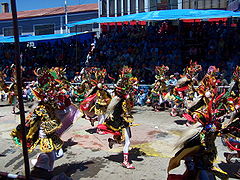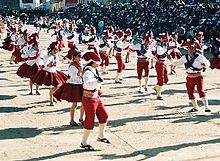
Back كرنفال أورورو Arabic Karneval von Oruro German Carnaval de Oruro Spanish Carnaval d'Oruro French Карневал де Оруро Macedonian Carnaval van Oruro Dutch Carnaval de Oruro Portuguese Uru Uru pukllay Quechua Карнавал в Оруро Russian Karneval u Oruru Serbo-Croatian
| Oruro Carnival | |
|---|---|
 Diablada dance at the Oruro Carnival 2007 | |
| Type | cultural, religious, Christian |
| Significance | Celebration prior to fasting season of Lent. |
| Celebrations | Parades, parties, open-air performances |
| Begins | Friday before Ash Wednesday (55 days to Easter) |
| Ends | Ash Wednesday noon (46 days before Easter) |
| 2024 date | Afternoon, February 5 – midday, February 14 |
| 2025 date | Afternoon, February 24 – midday, March 5 |
| 2026 date | Afternoon, February 9 – midday, February 18 |
| 2027 date | Afternoon, February 1 – midday, February 10 |
| Frequency | annual |
| Related to | Fiesta de La Candelaria, Carnival, Ash Wednesday, Lent |
| Carnival of Oruro | |
|---|---|
| Country | Bolivia |
| Reference | 00003 |
| Region | Latin America and the Caribbean |
| Inscription history | |
| Inscription | 2008 (3rd session) |
| List | Representative |
| Part of a series on the |
| Culture of Bolivia |
|---|
 |
| History |
| People |


The Carnival of Oruro is a religious and cultural festival in Oruro, Bolivia. Originally an indigenous festival, the celebration later was transformed to incorporate a Christian ritual around the Virgin of Socavón. The carnival is one of UNESCO's Masterpieces of the Oral and Intangible Heritage of Humanity.
Throughout the festival, more than 48 groups of folk dancers specializing in 18 different folk dances perform a pilgrimage to the Shrine of the Tunnel every Saturday of the carnival in a traditional parade. The traditional Llama llama or Diablada became the leading traditional dance of the festival.